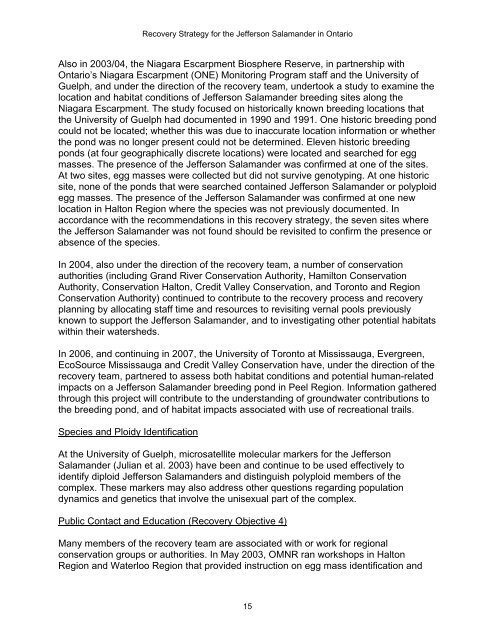Jefferson Salamander - Amphibian Specialist Group
Jefferson Salamander - Amphibian Specialist Group
Jefferson Salamander - Amphibian Specialist Group
Create successful ePaper yourself
Turn your PDF publications into a flip-book with our unique Google optimized e-Paper software.
Recovery Strategy for the <strong>Jefferson</strong> <strong>Salamander</strong> in OntarioAlso in 2003/04, the Niagara Escarpment Biosphere Reserve, in partnership withOntario’s Niagara Escarpment (ONE) Monitoring Program staff and the University ofGuelph, and under the direction of the recovery team, undertook a study to examine thelocation and habitat conditions of <strong>Jefferson</strong> <strong>Salamander</strong> breeding sites along theNiagara Escarpment. The study focused on historically known breeding locations thatthe University of Guelph had documented in 1990 and 1991. One historic breeding pondcould not be located; whether this was due to inaccurate location information or whetherthe pond was no longer present could not be determined. Eleven historic breedingponds (at four geographically discrete locations) were located and searched for eggmasses. The presence of the <strong>Jefferson</strong> <strong>Salamander</strong> was confirmed at one of the sites.At two sites, egg masses were collected but did not survive genotyping. At one historicsite, none of the ponds that were searched contained <strong>Jefferson</strong> <strong>Salamander</strong> or polyploidegg masses. The presence of the <strong>Jefferson</strong> <strong>Salamander</strong> was confirmed at one newlocation in Halton Region where the species was not previously documented. Inaccordance with the recommendations in this recovery strategy, the seven sites wherethe <strong>Jefferson</strong> <strong>Salamander</strong> was not found should be revisited to confirm the presence orabsence of the species.In 2004, also under the direction of the recovery team, a number of conservationauthorities (including Grand River Conservation Authority, Hamilton ConservationAuthority, Conservation Halton, Credit Valley Conservation, and Toronto and RegionConservation Authority) continued to contribute to the recovery process and recoveryplanning by allocating staff time and resources to revisiting vernal pools previouslyknown to support the <strong>Jefferson</strong> <strong>Salamander</strong>, and to investigating other potential habitatswithin their watersheds.In 2006, and continuing in 2007, the University of Toronto at Mississauga, Evergreen,EcoSource Mississauga and Credit Valley Conservation have, under the direction of therecovery team, partnered to assess both habitat conditions and potential human-relatedimpacts on a <strong>Jefferson</strong> <strong>Salamander</strong> breeding pond in Peel Region. Information gatheredthrough this project will contribute to the understanding of groundwater contributions tothe breeding pond, and of habitat impacts associated with use of recreational trails.Species and Ploidy IdentificationAt the University of Guelph, microsatellite molecular markers for the <strong>Jefferson</strong><strong>Salamander</strong> (Julian et al. 2003) have been and continue to be used effectively toidentify diploid <strong>Jefferson</strong> <strong>Salamander</strong>s and distinguish polyploid members of thecomplex. These markers may also address other questions regarding populationdynamics and genetics that involve the unisexual part of the complex.Public Contact and Education (Recovery Objective 4)Many members of the recovery team are associated with or work for regionalconservation groups or authorities. In May 2003, OMNR ran workshops in HaltonRegion and Waterloo Region that provided instruction on egg mass identification and15
















